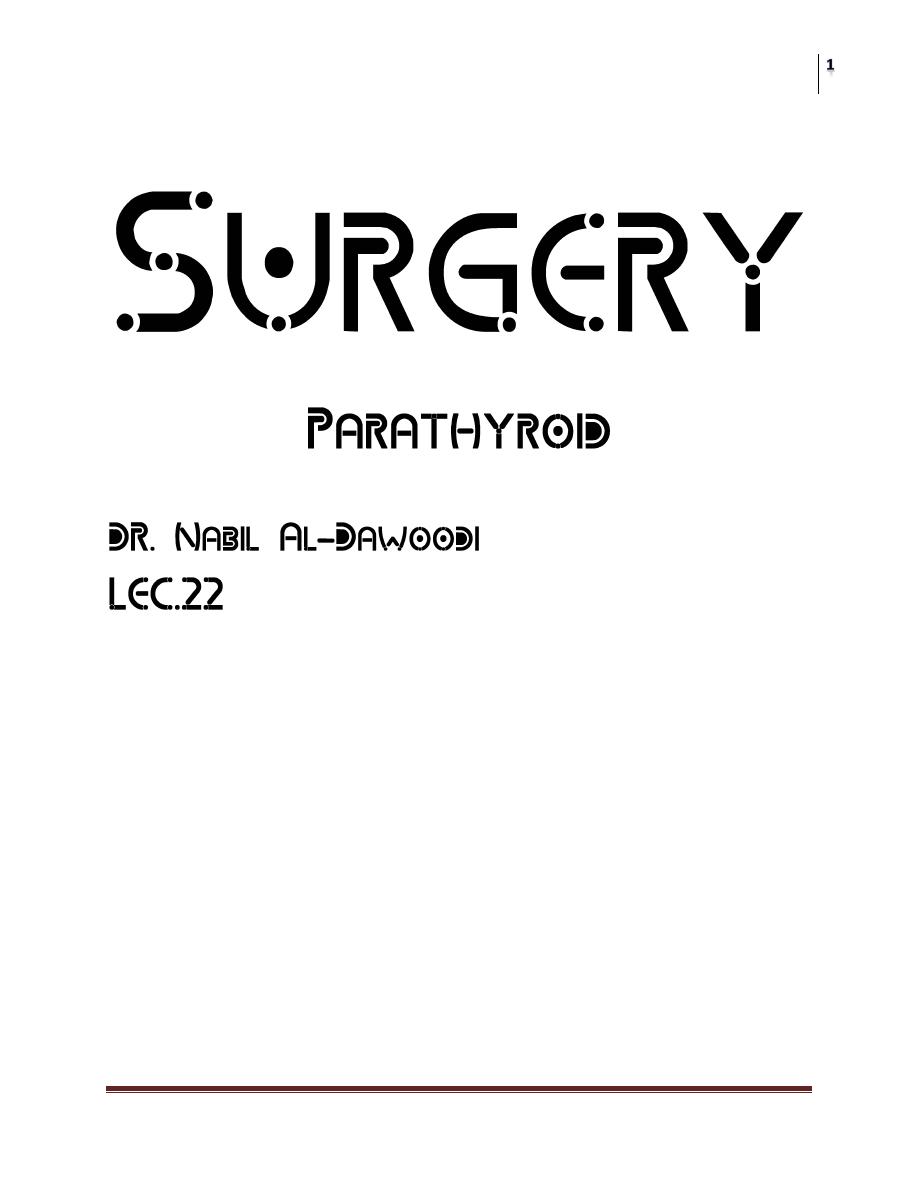
Surgery
Parathyroid
Dr. Nabil Al-Dawoodi
Lec. 22
Anatomy
Normal glands are: soft, Oval, & Khaki colored.
They measure up to 6mm in length & are arranged in pairs often closely applied to
the post. Aspect of the thyroid gland inside or outside its capsule
The upper pair is more constant then the lower.
Physiology
The glands secrete parathyroid hormone (PTH) & inactive PTH fragments. The
Former raises S.calcium level by binding to PTH receptor.
In the kidney it:
1. Stimulates Ca++ reabsorption
2. Inhibits phosphate reabsorption
3. Stimulates the synthesis of Vit.D

Surgery
Parathyroid
Dr. Nabil Al-Dawoodi
Lec. 22
IN bone it:
Stimulates resorption by increase osteoclast activity.
A rise in S.Ca++ decrease PTH level.
1- PRIMARY HYPERPARATHYRODISM:
This may result from:
1- Parathyroid adenoma (85%).
2- Diffuse parathyroid hyperplasia (15%).
3- Rarely from carcinoma of the parathyroid.
Hyperparathyroidism is the commonest component of MEN I syndrome.
Sign & symptoms:
1. Stones: Renal calculi occur in 5% of patients with hyperparathyroidism. All
patients with renal calculi should have their S. Calcium & phosphate
checked.
2. Bones: Osteitis fibrosa cystic (Von recklinghausen's disease), Bone pain &
fractures may occur.
3. Abdominal groans: Dyspepsia, constipation & peptic ulceration may occur;
pancreatitis is a complication of hyperparathyroidism.
4. Moans: Psychiatric manifestations may occur (e.g confusion, depression,
psychosis).
However, many patients have non-specific symptoms (e.g: weakness, fatigue,
lethargy, arthralgia, anorexia, weight loss, thirst & polyuria). Some patients are
asymptomatic. Hypercalcemic being detected on routine tests performed for other
reasons.
Investigations:
• Ca+2 increases.
• Phosphates usually decrease.
• PTH increase.
• Urine Ca+2 increases.
Radiographs:
Skull: may show characteristic (wound glass) appearance, abnormal sella turcica if
MEN were associated with pituitary tumors.

Surgery
Parathyroid
Dr. Nabil Al-Dawoodi
Lec. 22
Hands: subperiosteal resorption of bone (best seen on radial aspect of middle
phalanges & tufts of terminal phalange).
Abdomen: nephrocalcinosis.
Preoperative localization of the glands:
U/S.
Technetium/Thalium scanning.
CT scan.
SPECT (single proton emission computerized tomography).
Selective venous sampling.
PTH assay from draining veins may be used.
Differential diagnosis:
3
o
hyperparathyroidism.
Hypercalcaemia of malignancy (breast, prostate, lung, kidney, thyroid).
Myeloma.
Drugs (thiazides).
Vit. D excess.
Hyperthyroidism.
Immobilization.
Milk alkali syndrome.
Sacroidosis.
Familial hypocalciuric hypercalceamia
Pheocromocytoma.
TREATMENT:
Medical:
Long term surveillance.
General measures (hydration + avoidance of excessive calcium intake +
cessation of thiazides or lithium).
Oestrogen or bisphosphate therapy to decrease S.Ca+2 levels.
Sever hypercalcaemia is a medical emergency requiring:
Adequate hydration.
Bisphodphate therapy (pamidronate 60-90 mg i.v. over 4 hours).

Surgery
Parathyroid
Dr. Nabil Al-Dawoodi
Lec. 22
Surgical:
Preoperative localization of the gland is helpful.
Parathyroid adenoma should be surgically removed.
Hyperplasia of all glands: remove all or remove 31/2 and mark the residual
half-gland with surgical clip.
Thoracotomy may be needed sometimes.
Hypoparathyroidism may occur postoperatively –< give 1-alpha vit.D is
curative alone.
Recurrent hypercalcaemia postoperatively is an indication of re-exploration
to remove more parathyroid tissue from the clipped residual half.
2- RENAL SECONDARY HYPERPARATHYROIDISM:
This usually occurs in patient with ORE although it may be seen in any
situation which results in low S.Ca+2.
Hypocalcaemia stimulate the parathyroid hyperplasia.
CRP impairs Vit.D synthesis leads to impaired Ca absorption leads to
hypocalcaemia and hyperphosphatemia.
Signs and symptoms:
These are of CRP, bone-pain, pruritis and metastatic extravascular calcification.
Treatment:
Correct the cause.
Aluminum hydroxide to decrease phosphate.
Vit.D3 calicium supplements.
High calcium dialysate.
Surgery is reserved for refractory cases.
3- Tertiary hyperparathyroidism:
The parathyroid hyperplasia of long-term renal disease becomes autonomous
despite the return of calcium levels to normal following successful renal
transplantation.
The symptoms are those of 2o hyperthyroidism.
Rx is subtotal parathyroidectomy.

Surgery
Parathyroid
Dr. Nabil Al-Dawoodi
Lec. 22
Hypoparathyroidism:
Causes:
1) Congenital:
a) DiGeorge's syndrome: absent parathyroid + immunodificiency due to thymic
aplasia & cardiac defect.
b) Autoimmune polyglandular syndrome.
2) Acquired:
a) pst op. (thyroidectomy, L.N.dissection)
b) Hemochromatosis.
c) Wilson's disease.
Signs and symptoms:
Hypoparathyroidism causes hapocalcaemia.
Acute hypocalcaemia causes periorpital tingling & numbness + parasthesias
of the fingers and toes.
In severe cases ventricular arrhythmias & laryngeal spasm may occur.
Chronic hypocalcaemia may cause cataracts, bone mineralization defects &
extrapyramidal disorders, percussion of the facial n. just below the zygoma
causes contraction of the ipsi-lateral facial muscles (Chovostek's sign).
Carpopedal spasm can be induced by occlusion of the arm with a blood of
pressure cuff for 3 min. (trousseau's sign).
ECG changes include prolonged QT intervals & QRS complex changes.
Treatment:
Symptomatic hypocalcaemia is a medical emergency.
In severe cases (less than 1.95 mmol./L): give 10 ml. of 10% calcium
gluconate slowly i.v., or i.v. calcium over a more prolonged period.
Magnesium supplements may be needed as a hypomagnesaemia may
coexist.
Milk, oral calcium supplements, 1-alpha-vit.D can be used in less sever &
chronic cases.

Surgery
Parathyroid
Dr. Nabil Al-Dawoodi
Lec. 22
Multiple endocrine neoplasia (MEN) syndromes:
Always consider that a patient with hyperparathyroidism may also have
other endocrine adenomas.
The cells involved, irrespective of the site, have the common biochemical
characteristics of amine precursor uptake & decarboxylation (APUD cells).
The disease is inherited as an autosomal dominant trait, the manifestations in
any one family tend to be similar and all members of the family should be
investigated.
The following Note is just for knowledge:
APUD constitute a group of apparently unrelated endocrine cells, these cells share
the common function of secreting a low molecular weight polypeptide hormone.
There are several different types which secrete the hormones secretin,
cholecystokinin and several others. The name is derived from an acronym,
referring to the following:
a- Amine - for high amine content.
b- Precursor Uptake - for high uptake of (amine) precursors.
c- Decarboxylase - for high content of the enzyme amino acid decarboxylase (for
conversion of precursors to amines).
MEN 1 syndrome:
The most common variant involves the:
Parathyroids (90%): There is parathyroid hyperplasia.
Pancreatic islets (80%): The pancreatic tumour may secrete gastrin
(Zollinger Ellison syndrome), or insulinoma, somatostatin, or vasoactive
intestinal peptide (VIP) causing watery diarrhea hypokalemia achlorhydria
(WDHA) syndrome (pancreatic cholera).
Pituitary gland (65%): a chromophobe adenoma of the pituitary gland which
may cause hypophosphatemia or acromegaly.
The thyroid.
Adrenal cortex.
Rx: surgical excision.

Surgery
Parathyroid
Dr. Nabil Al-Dawoodi
Lec. 22
MENIIA syndrome:
Is inherited as an autosomal dominant fashion.
Mutations in the RET proto-oncogene are responsible for MEN2A, MEN2B, &
FMTC (familiar non-MEN medullary thyroid ca.).
30% have parathyroid hyperplasia.
The associated lesions are MS (produces calcitonin)-(100%), pheochromocytoma
(42%).
MENIIB
MTC (Multiple Thyroid Carcinoma) 100% + Mucosal neuromas leads to (lumpy &
bumpy) pheochromocytoma (40%-50%) + megacolon (100%) + ganglioneuroma
of the intestine.
